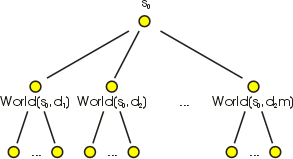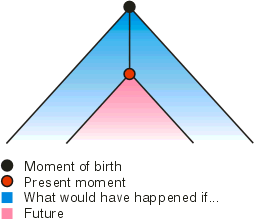This
paper is the sequel of "AI - What is this"
(ed. 11/2000). We said there that we want to create a device which in an
arbitrary world will cope not worse than a human being. Let us think what
is an arbitrary world and how our device would cope in such world. We are
going to ask ourselves how many are the possible world’s states and when
two worlds are indistinguishable?
We said that an arbitrary world
is an arbitrary function World(s, d),
the arguments of which are the world’s state and the influence that our
device has on the world. The result of this function is the world’s new
state. We said that the device works out finite information (m
bits), i.e. the possible influence actions towards the world are finite
(2m).
Let us have an arbitrary world.
We are going to build the tree of the attainable world’s states. An attainable
world’s state will be the one that can be reached by our device (or the
one that the device can bring the world to). In the tree’s root we are
going to place the state s0.
This world’s state will be reached at the moment of birth. Inheritors of
s0
will be the states World(s0, di)
where di runs through all possible
actions (as we have already said, they are a finite number). These states
can be reached in a moment one (if the action in moment zero was the respective
one).
By analogy, we define the inheritors
of the inheritors and so on. We get an infinite tree with countably many
knots. We will call this tree the tree of the attainable states.

From the tree of the attainable
states we can easily get another tree, which we will call the tree of the
world. This will be the same tree but at each knot instead some state (si)
we will juxtapose View(si),
i.g. instead the respective world’s state we will juxtapose the information
the device gets as an entrance when it is in that state (what it sees).
Why did we call this tree with the pretentious name tree of the world?
It is because that if two worlds have the same tree of the world then they
are absolutely indistinguishable from the point of view of the device.
No matter what experiment it would carry out, it would get the same result
in both worlds because with the same sequence of actions it would see the
same things.
|
Now we are ready to answer the
question how many the world’s states are. They can be arbitrary many, but
because only the attainable ones matter we can safely consider that the
others do not exist. It means that if we throw out the unattainable states
from a world, we will get a world indistinguishable from the given one.
The newly obtained world will have no more than countably many states.
What is the life of our device?
This is a path in the tree of the world, starting from the root View(s0).
This path is potentially infinite but at a given moment t
of its life the path has length t.
What does our device know at the moment t?
Up to this moment it knows only its own life path, the other knots are
- what would have happened if it would have done another thing or what
will happen in future. All these are things that our device does not know
and only can suppose about them.

That is to say, our device is at
the moment t of its life and its task
is to understand the world, to understand the principles that make it move.
This understanding of the world is necessary for it to be able in future
to choose its way better and to get a better mark for its actions. Well,
the understanding of the world is important, but how it can be done, how
from a finite path in a infinite tree a whole tree can be built.
The latter (to be built a whole
tree) is a too ambitious task. This means the world to be fully understood.
If you understand fully the world you live in, you will not need to carry
out experiments, because you will know the result you will get. For example,
you will not have to look for your things, because you will already know
where they are, even when you throw dice you will know what will the result
be, also you will know the lottery numbers. As you can see, you do not
know fully the world you live in and it is not sensible for us to hope
our device to achieve such a result. We can have full knowledge of the
world only in very simple worlds, but even there, even if we have a model,
giving us a full description of the world, we can never be sure that this
is a correct model. This model could have proved itself million times,
but we do not have guarantees that in the million and first one it will
not mislead us.
|